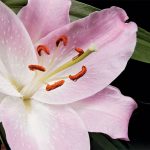 Female reproductive part of a flower.
Female reproductive part of a flower.
(In apocarpous flowers) the unit of separate carpel, style and stigma (Bell, 2008, Hickey & King, 2000);
(In syncarpous flowers) the whole gynoecium (Bell, 2008, Hickey & King, 2000);
The female organ of a flower, consisting when complete of ovary, style and stigma (Jackson, 1928).
The female organ of a flower, ordinarily differentiated into an ovary, style, and stigma.
Female flowering structure, typically consisting of an ovary (containing one or more eggs, later to be fertilized and grow into seeds), a neck-like style, and a stigma which receives pollen from the male flowering structure, or anther. Pistils and anthers may be contained within the same flower or in separate flowers.
The egg-bearing (female) part of a flower, which includes the ovary, style, and stigma.
The female organ of the flower, composed of ovary, style, and stigma. Once fertilized, it develops the fruit.
The ovary-bearing female organ of a flower.
The organ of a flower which bears ovules and later seeds.
The female organs of a flower (usually central), taken as a whole.
Female reproductive structures with ovary, containing ovules that develop into seeds, and style, a stalk above the ovary bearing the stigma, which is the receptacle for pollen, which contains sperm.
The female organ of a flower, composed of an ovary, a slender style, and a stigma or stigmas at tip.
The seed-producing, or female, unit of a flower, typically consisting of the ovary, style, and stigma; a flower may have one to several separate pistils.
The female part of a flower, consisting of the stigma, style, and ovary.
The female organ of a flower comprising ovary (the ‘seed box’), stigma (the sticky or feathery tip of the pistil which receives the pollen) and style (the part that connects the ovary and stigma).
The female organ of a flower, consisting of the ovary or seed-box, the style and the stigma which develop into the fruit after fertilization.
